The Intel Core i7-12700K and Core i5-12600K Review: High Performance For the Mid-Range
by Gavin Bonshor on March 29, 2022 8:00 AM ESTCPU Benchmark Performance: Power, Office, and Science
Our previous set of ‘office’ benchmarks have often been a mix of science and synthetics, so this time we wanted to keep our office section purely on real-world performance.
For the remainder of the testing in this review of the Core i7-12700K and i5-12600K, we are using DDR5 memory at the following settings:
- DDR5-4800(B) CL40
Power
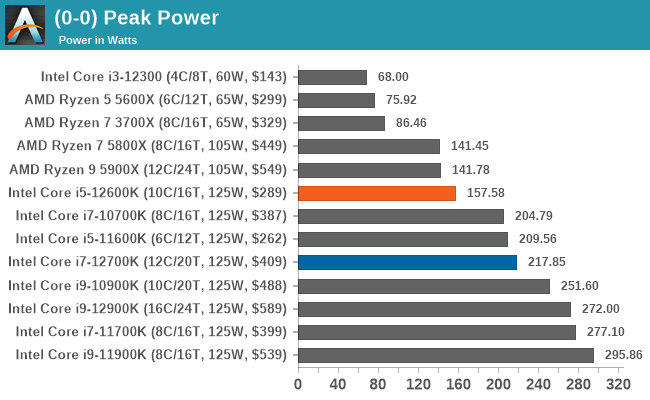
Comparing power draw to other competing CPUs, both the Core i7-12700K and Core i5-12600K are noticeably more power-efficient than previous generations including both Intel's 11th Gen and 10th Gen Core. Though at full-load with no overclocking, AMD's Ryzen 5000 and 3000 series processors remain much more power-efficient.
Office
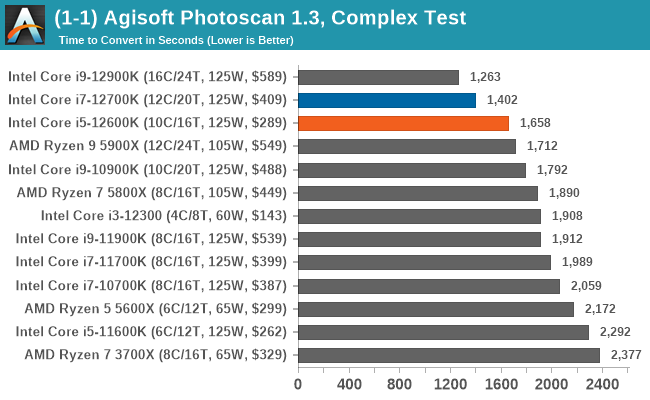
In our office benchmarks, Intel's 12th Gen Core reigns supreme in Agisoft Photoscan due to its higher core frequency and IPC performance.
Science
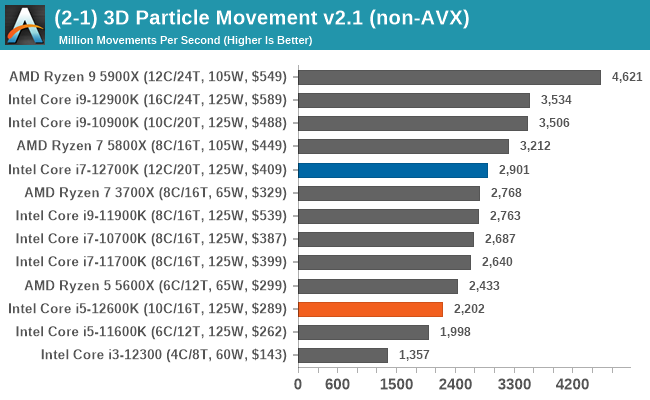
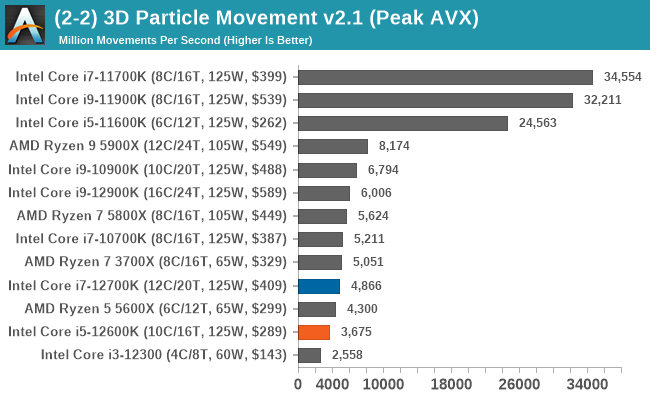

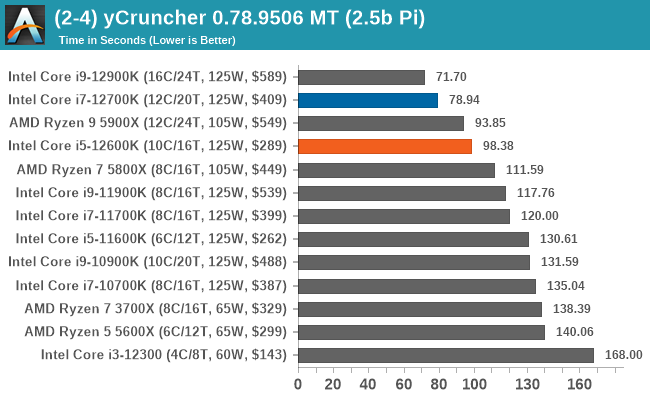
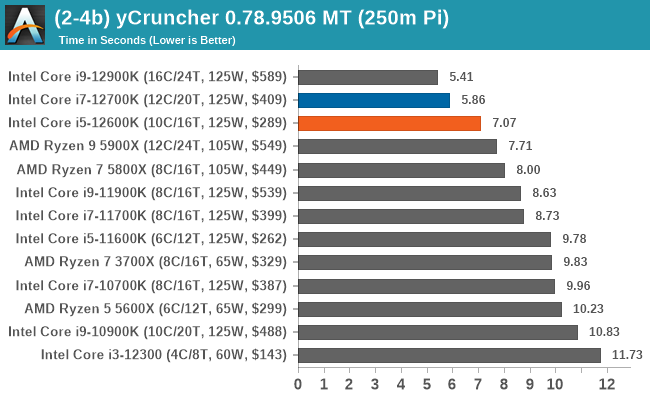
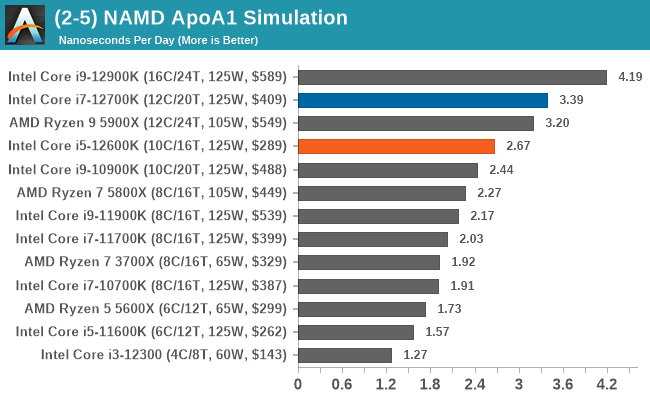
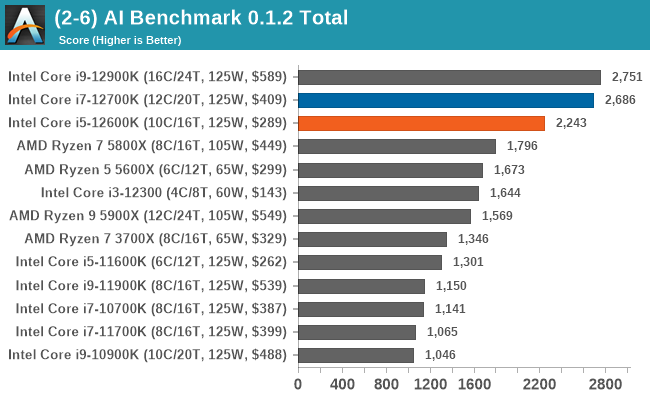
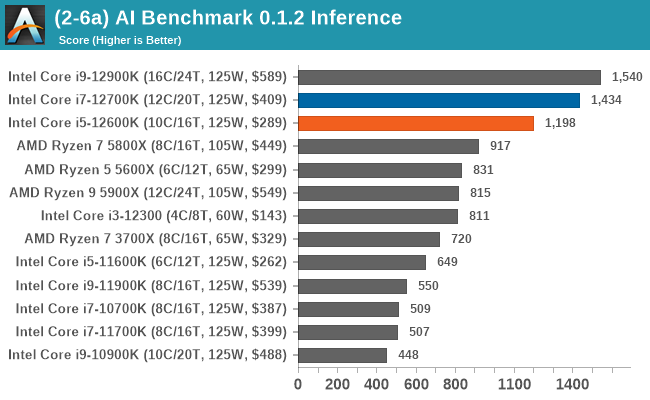
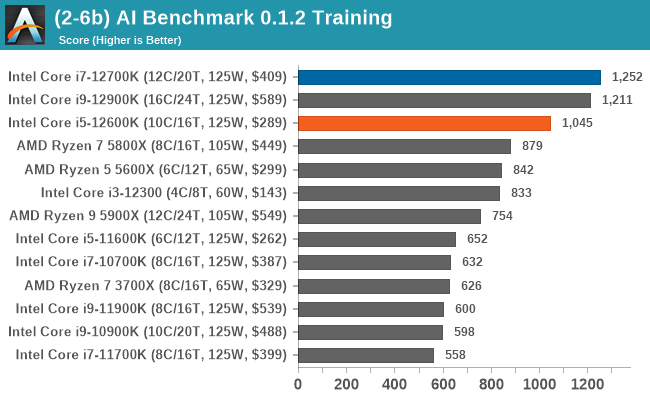
In the majority of our science-based benchmarks, both the Core i7 and Core i5 did well. The only benchmarks that didn't favor the 12th Gen Core series processors were in 3DPM 2.1, but more specifically in the AVX test.










196 Comments
View All Comments
kwohlt - Wednesday, March 30, 2022 - link
Just not how it works. I would understand if AMD and Intel were releasing CPUs in the same month, but Zen 4 H2 2022, and Alder Lake is Q4 2021... Besides, Raptor Lake and Zen 4 will be launching within weeks of each other. That's the competition. It was AMD's choice not to release a new architecture in 2021.Mike Bruzzone - Tuesday, April 5, 2022 - link
@kwohit "It was AMD's choice not to release a new architecture in 2021." Gets down to production economic efficiency. Acceleration can be devastating when AMD channels, as Intel channels have demonstrated, still have tons of prior generations of product, 'accumulated capital values' to sell off and required to finance new procurements. Matisse was a surplus run that finally sold off on the last half of 2021. Leaves Vermeer and Cezanne to move out where Rembrandt is the mainstay throughout 2022 where AMD will finally make a mobile statement before entering 11.1.22 launch that is Zen 4 peak production so there should be a lot of availability. OEMS are supplied q3. AMD production structure this year is a two-tower suspension bridge with unilateral arch from tower abutment 1 to tower abutment 2. The deck is Rembrandt, Tower 1 is V5x refresh + TR5K required to pull up gross margin q2ish (a price support) Tower 2 is Rafael. Arch is Epyc and commercial GPU accelerators. Generally, AMD sales manages its production tails, run end slack, much better than Intel and Matisse was an anomaly but well timed in terms of AMD holding channels financially. New channel allocation is based on sales out so as any one channel seller sells off, OEM or otherwise, that earns reallocation access. mbmode_13h - Tuesday, April 5, 2022 - link
> Gets down to production economic efficiency.Not only that, but it actually takes time to design new chips. I think AMD simply didn't have an option to release Zen4 in 2021. Given all the demands on their engineering resources, it would've been too much. And even though their financials are healthy, it takes time to ramp up capacity (even if the job market is more conducive than it has been)!
> AMD production structure this year is a two-tower suspension bridge
> with unilateral arch from tower abutment 1 to tower abutment 2.
> The deck is Rembrandt, Tower 1 is V5x refresh + TR5K
> required to pull up gross margin q2ish (a price support) Tower 2 is Rafael.
> Arch is Epyc and commercial GPU accelerators.
Beautiful analogy!
Mike Bruzzone - Tuesday, April 5, 2022 - link
@mode_13th, thank you. An SA comments entering 2022 it's there somewhere in comment string. So tune in to Seeking Alpha.Lots of knowledgeable individuals participating in academy on SA on AMD, Intel Nvidia topics I cover and Dhierin Bechai on Boeing, incredible! I did the marginal cost analysis of Boeing per unit of production as a compliment in DB comment string must have been 24 months ago our conferring on the topic here's his latest.
https://seekingalpha.com/article/4499583-boeing-to...
mb
mode_13h - Wednesday, April 6, 2022 - link
> So tune in to Seeking Alpha.Sorry, mate. I get that's your jam, and I'm happy that you've found your calling. My core competencies and interests lie elsewhere.
I do love how you geek out on data analysis. I can get that way, when I'm analyzing a problem that's directly meaningful to me, in my work.
Mike Bruzzone - Thursday, April 7, 2022 - link
"analyzing a problem that's directly meaningful to me, in my work." Sure.We are all engineers when resolving technical challenges; creation, innovation and improvement over the learning curve of difficult solutions even if those solutions were difficult because the tools were nil, nascent or required invention themselves. "Geek out on data analysis", everyone likes a puzzle? Dependent how fast the puzzle gives up its secrets?
Engineering as a cross profession, cross practice challenge, the various sciences, everyone can and gets to be an engineer in their "meaningful work"
On Seeking Alpha, their can be banter but look for the engineer and technician authors / analysts.
mb
goatfajitas - Wednesday, March 30, 2022 - link
I like AMD, a very happy 5600x owner myself... But Zen 4 isnt out. Intel 12th gen is available for purchase right now today.- Later this year when Zen 4 is released it will bench against Intel 12th gen unless Intel 13th gen is out at that time. - just the way it is.
Pneumothorax - Friday, April 1, 2022 - link
I have a 5900x/5800x machines at home so I'm definitely no Intel guy, but AMD's Vermeer launch was much more "paper" than Intel's. Intel has been doing a superb job of getting/keeping alder lake in stock after launch while the whole 5XXX stack was very hard to get for over a year. I hate how everyone is so dependent on TSMC for everything.Mike Bruzzone - Tuesday, April 5, 2022 - link
@Pneumothorax" I hate how everyone is so dependent on TSMC for everything"
There r leading node customer oligarchies, quasi monopolies operating with(in) TSM too, but that presents a risky topic and I have my hands full with Intel. mb
Mike Bruzzone - Friday, April 1, 2022 - link
On Intel monopolization -All are aware how AMD got back into the market in 2017 midway through the period of time Intel was stuck (sabotaged) at 14/12 nm for six years; October 2014 through summer 2021, and yes, every next gen minor incremental quad frequency improvement and the premium, economic is the term, priced Extreme quad hexa octa multicores and their Xeon E5 commercial components.
I will not address how Intel was sabotaged in this monopoly note.
Intel's techniques of monopolization are not well understood, the reason why.
First to monopolize the channel financially on production volume in a first in first out procurement system in relation inventory holdings. Where once channel's ability to procure financially reaches its maximum capital threshold, others become locked out or second in line. Not to say through this period of time AMD did not suffer some second-class products.
The way Intel monopolized channels is very simple associated surplus production volume. Fill the channel with surplus production and few others fit. AMD from time to time and since 2017 beats this technique, not on supply, but on product good enough to pull through organically. Note while Intel product can pull through organically on nature demanders, the vast majority of Intel product is pushed onto end buyers by channels relying on financial field effects that drag product down channels like a baton in a relay race; think magnetics, associated primarily with the now defunct Intel Inside rebated fee 'attractor' that is not 'cooperative advertising' cost to the processor as INTC 10K falsely certified for 28 years. Intel Inside is processor ales contact related payments to end sales outlets; OEM direct, PC pub direct, Web direct, Broadcast direct (Shopping Channel), retail direct for their end sales out reports back to Intel. End sellers were paid $8.32 per processor in box or chassis, for 28 years, across 4,623,837,562 processors.
Channel's total take from Intel = $41,567,500,000. However that sum represents only half of channel's total Intel Inside take. Intel inside is a two part tied value charge.
Intel PC OEMs contractually (1993 until 2008) were required to match Intel's $8.32 payment per processor for end sales out of distribution chain reporting to Intel. After 2008 Intel stockholders picked up the cost of both charges; $16.64 in total. How this worked is that Intel would take the OEMs' half at the processor sale and place that half of the charge, debit it into any one specific OEMs 'rebated fee' account pool. At the end sale, Intel would pay the inventory out reporter not only the OEMs contribution for any specific brand manufacturer's system sale but Intel would match that sum out of Intel's own funds paid by stockholders. In this circular system of payments the OEMs regulating triggering charge is pushed down the distribution sales chain puling any one processor or processor in system like a magnetic 'baton' in a relay race passed from one whole sale operator to another broker/reseller all the way to the end seller. And then Intel would pay that end seller both the regulating OEM trigger crediting out of any OEMs 'rebated fee' pool of debit accruals and than Intel would also match that contribution out of Intel's pocket. How many OEMs participated in this closed loop structure, seven to eleven that's it. Seven to eleven Intel primary dealers who purchase every single processor Intel produces (other than tray sales) to monopolize the total annual fund of Intel Inside payments from Intel, That act effectively ties OEMs financially to end sales outs.
OEMs are also Intel's primary processor resellers. They broker off to secondary integration channels what they can't immediately sell in a computer in real time with a twist. The twist is they do not pass their Intel Inside credits to the secondary CPU customer in a broker resale. This artificially weights any 1st tier OEMs pool gluing them financially 'tied' to end sales outlets (PC Week, PC MAG, PCW, Computer Shopper, Shopping Channel, Newegg, Frys, Best Buy, MicroCenter etc) Ar tied to any OEMs Intel Inside 'rebated fee pools procuring majority of all Intel's processor production volume in any period.
On the weight of the OEM originating rebated fee pools, Intel Inside attractor driving processors down channels like a magnet becomes self perpetuating so long as Intel processor volumes increase every cycle, think every next quarter. FTC Docket 9341 in 2010 eliminated the roll over effect to one year, or one generation of product, because Intel Inside funds earned on last Intel gen were being relied as an OEM spring board to launch every next Intel generation of processors from Intel Inside debit accruals earned and banked into 'weighted pools' from the prior generation of processor procurements.
Now who really pays that total of $16.64 in channel cartel administrative costs for every Intel Inside branded processor in box or computer? This channel (exclusive dealing) 'toll way' charge is passed to the end buyer who pays that cost of Intel Inside in the processor and/or computer purchase offsetting the cost of the OEM triggering (or regulating) charge and the cost of the Intel matching 'kick back' charge; rebated fee, brand fee reward, 'tied charge back registered metering' cost of channel cartel administration of Intel inventory sales out reports to Intel.
Think administrative fee, the cost of metering sales and reporting the result to Intel is how inventory is tracked in the channel all the way back to the factory' flow metering, registered metering.
Now here's the second twist, why Intel produces volumes of product in excess of real time demand? Intel does this to sustain the funding of Moore's doubling of transistor axiom every 18 to 24 months pursuant Rocks axiom that notes a doubling of cost every next lithography node. So how does Intel generate a doubling of CapEx requirement every two years. Intel sells x2 to x3 the processor volumes required over real time end market computer demand, surplus production, in anyone lithography cycle is relied to raise the continuous CapEx requirement. And Intel offs every processor produced, x2 to x3 the volume over real time PC demand, sold through seven to eleven OEMs you know who they are, every cycle, who then resell what they do not need as overage (reducing their original procurement cost) to others not to get stuck with any rotting tomato's.
Now recall the first twist, Intel Inside debits to be credited into future time are attached to everyone of those processors originally purchased by seven to eleven Intel primary Computer OEMs who are also in the business of Intel microprocessor broker dealer. First tier OEM dealers do not pass the Intel Inside debit for payment, store redemption coupon is a way to think about it, on their broker resale. Seven to eleven Intel primary dealers hold 100% of the originating Intel Inside values and this ties them to end sales outlets. End Sales outlets, ZD, IDG, VNU, Big Retail all know exactly which Intel OEMs maintain the largest pools of Intel Inside debits which they want to have credited to them is why DELL wins a disproportionate number of PC magazine and other media PC sales preview outlet Editor's Choice Awards.
No end seller left Intel Inside on the table. Intel Inside paid sales, for registering metering 'brand fee reward payments' sold through first, as sellers competed to clear anyone Intel primary Computer OEMs waiting pools of credits, all other processors sold through last.
FTC Docket 9341 secures Intel discontinuation of Intel Inside entering 2019, in violation of Docket 9341 consent order. The result is achieved verse Intel legal stubbornness selling Intel on the cost optimization benefit of getting rid of Intel Inside all those fund drop to the bottom line.
Intel Inside no longer presents an Intel unnecessary avoidable cost to end buyers.
Intel is currently being monitored for reconfiguring from producing for supply to producing for real time demand, that if IFS is to be successful, Intel must achieve. It is not known how Intel will pay for Rock's doubling of costs every node sans the previous surplus production technique, however, cost optimization and continuing to close financial leaks and eliminating waste is key. Intel has demonstrated a move to demand based production at Tiger Octa mobile, Alder Lake and Ice Lake.
Currently there is a $19,805,500,000 offer on the table for Intel Board approval pursuant Intel Inside consumer discriminatory price fix recovery and I expect Board approval before end of year.
Proof of purchase will be for purchases from 2008 through 2018, sales receipt, property tag, proof of OS license.
Mike Bruzzone, Camp Marketing